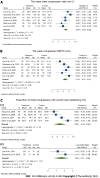Video-assisted bystander cardiopulmonary resuscitation improves the quality of chest compressions during simulated cardiac arrests: A systemic review and meta-analysis
- PMID: 36387811
- PMCID: PMC9649565
- DOI: 10.12998/wjcc.v10.i31.11442
Video-assisted bystander cardiopulmonary resuscitation improves the quality of chest compressions during simulated cardiac arrests: A systemic review and meta-analysis
Abstract
Background: It remains unclear whether video aids can improve the quality of bystander cardiopulmonary resuscitation (CPR).
Aim: To summarize simulation-based studies aiming at improving bystander CPR associated with the quality of chest compression and time-related quality parameters.
Methods: The systematic review was conducted according to the PRISMA guidelines. All relevant studies were searched through PubMed, EMBASE, Medline and Cochrane Library databases. The risk of bias was evaluated using the Cochrane collaboration tool.
Results: A total of 259 studies were eligible for inclusion, and 6 randomised controlled trial studies were ultimately included. The results of meta-analysis indicated that video-assisted CPR (V-CPR) was significantly associated with the improved mean chest compression rate [OR = 0.66 (0.49-0.82), P < 0.001], and the proportion of chest compression with correct hand positioning [OR = 1.63 (0.71-2.55), P < 0.001]. However, the difference in mean chest compression depth was not statistically significant [OR = 0.18 (-0.07-0.42), P = 0.15], and V-CPR was not associated with the time to first chest compression compared to telecommunicator CPR [OR = -0.12 (-0.88-0.63), P = 0.75].
Conclusion: Video real-time guidance by the dispatcher can improve the quality of bystander CPR to a certain extent. However, the quality is still not ideal, and there is a lack of guidance caused by poor video signal or inadequate interaction.
Keywords: Dispatcher-assisted cardiopulmonary resuscitation; Quality of chest compressions; Simulated cardiac arrests; Video.
©The Author(s) 2022. Published by Baishideng Publishing Group Inc. All rights reserved.
Conflict of interest statement
Conflict-of-interest statement: All authors report no relevant conflict of interest for this article.
Figures
Similar articles
-
Interactive video instruction improves the quality of dispatcher-assisted chest compression-only cardiopulmonary resuscitation in simulated cardiac arrests.Crit Care Med. 2009 Feb;37(2):490-5. doi: 10.1097/CCM.0b013e31819573a5. Crit Care Med. 2009. PMID: 19114904 Clinical Trial.
-
Outcomes of audio-instructed and video-instructed dispatcher-assisted cardiopulmonary resuscitation: a systematic review and meta-analysis.Ann Med. 2022 Dec;54(1):464-471. doi: 10.1080/07853890.2022.2032314. Ann Med. 2022. PMID: 35107406 Free PMC article.
-
Video-assisted cardiopulmonary resuscitation via smartphone improves quality of resuscitation: A randomised controlled simulation trial.Eur J Anaesthesiol. 2020 Apr;37(4):294-302. doi: 10.1097/EJA.0000000000001177. Eur J Anaesthesiol. 2020. PMID: 32073408 Clinical Trial.
-
Dispatcher-assisted compression-only cardiopulmonary resuscitation provides best quality cardiopulmonary resuscitation by laypersons: A randomised controlled single-blinded manikin trial.Eur J Anaesthesiol. 2016 Aug;33(8):575-80. doi: 10.1097/EJA.0000000000000432. Eur J Anaesthesiol. 2016. PMID: 26908002 Clinical Trial.
-
Impact of dispatcher-assisted cardiopulmonary resuscitation on neurologically intact survival in out-of-hospital cardiac arrest: a systematic review.Scand J Trauma Resusc Emerg Med. 2021 May 24;29(1):70. doi: 10.1186/s13049-021-00875-5. Scand J Trauma Resusc Emerg Med. 2021. PMID: 34030706 Free PMC article.
Cited by
-
Could video assisted CPR improve treatment in complex cardiac arrest situations? - A case report.Resusc Plus. 2024 Dec 13;21:100836. doi: 10.1016/j.resplu.2024.100836. eCollection 2025 Jan. Resusc Plus. 2024. PMID: 39758756 Free PMC article.
-
Evaluation of the Effectiveness of Animated Images in First Aid for Infants with Foreign Body Airway Obstruction: A Simulation Study.J Clin Med. 2025 Apr 20;14(8):2839. doi: 10.3390/jcm14082839. J Clin Med. 2025. PMID: 40283669 Free PMC article.
References
-
- Berdowski J, Berg RA, Tijssen JG, Koster RW. Global incidences of out-of-hospital cardiac arrest and survival rates: Systematic review of 67 prospective studies. Resuscitation. 2010;81:1479–1487. - PubMed
-
- Wong CX, Brown A, Lau DH, Chugh SS, Albert CM, Kalman JM, Sanders P. Epidemiology of Sudden Cardiac Death: Global and Regional Perspectives. Heart Lung Circ. 2019;28:6–14. - PubMed
-
- Sasson C, Rogers MA, Dahl J, Kellermann AL. Predictors of survival from out-of-hospital cardiac arrest: a systematic review and meta-analysis. Circ Cardiovasc Qual Outcomes. 2010;3:63–81. - PubMed
-
- Meaney PA, Bobrow BJ, Mancini ME, Christenson J, de Caen AR, Bhanji F, Abella BS, Kleinman ME, Edelson DP, Berg RA, Aufderheide TP, Menon V, Leary M CPR Quality Summit Investigators, the American Heart Association Emergency Cardiovascular Care Committee, and the Council on Cardiopulmonary, Critical Care, Perioperative and Resuscitation. Cardiopulmonary resuscitation quality: [corrected] improving cardiac resuscitation outcomes both inside and outside the hospital: a consensus statement from the American Heart Association. Circulation. 2013;128:417–435. - PubMed
-
- Dumas F, Rea TD, Fahrenbruch C, Rosenqvist M, Faxén J, Svensson L, Eisenberg MS, Bohm K. Chest compression alone cardiopulmonary resuscitation is associated with better long-term survival compared with standard cardiopulmonary resuscitation. Circulation. 2013;127:435–441. - PubMed
LinkOut - more resources
Full Text Sources
Medical





